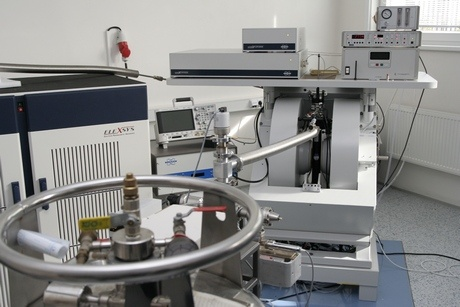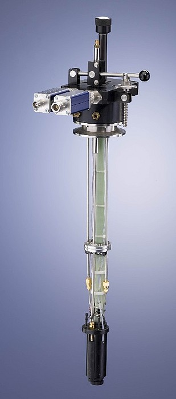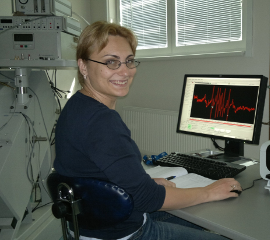EPR laboratory is equipped by spectrometer Bruker ELEXSYS E580, which is a top-class scientific device to measure electron paramagnetic (spin) resonance in both modes – classic (CW) and pulsed (FT), in the common X-band (9.4-9.8 GHz) as well as high-frequency Q-band (34 GHz). Flexibility of the system is achieved by modular architecture, which allows operation in CW mode or as a CW/FT system. In both frequency bands the spectrometer contains a system for measurements of ENDOR (electron-nuclear double resonance) and ELDOR (electron-electron double resonance). The Spectrometer operates in the 4 – 300 K temperature range. EPR method allows determining the structure, dynamics and space distribution of paramagnetic particles at atomic level. One can analyse solid state matter, soft materials (e.g. gels), liquids and bio samples. The technique is suitable for investigation of the effect of the structure on functional properties of materials. The typical example of this technique usage is the investigation of structure defects in semiconductors and multifunctional materials (e.g. , ferroelectric and piezoelectric materials or ferroelectrics), the identification of different gels of adsorbed molecules on surfaces (e.g. implants) etc.

EPR samples must contain unpaired electrons (an electron that occupies an orbital of an atom singly, rather than as part of an electron pair):
- transition metal ions (Fe, Cu, Mn, Co, Mo, Ni, et al.),
- free radicals (typically carbon, nitrogen or oxygen containing compounds).
- defect centers (semiconductors, ionizing radiation, N centers in diamond, et al.)
- g-tensor values
- Superhyperfine interaction parameters between electron spins and nearby nuclear spins and nuclear spin relaxation
- Electron spin density distribution, distances and bonding angles.
- Electron spin relaxation times
- Spin density distribution and distances through the hyperfine interaction between electron and nuclear spins
- Correlations and exchange rates
- Long range distances by electron-electron spin dipolar coupling
- Distance between the electron spins in the range from 10 to 80 Angstrom.
Bruker X-/Q- band E580 FT/CW ELEXSYS spectrometer
Main features:
- Frequency range: X-band (9.2-9.9 GHz) and Q-band (34-35 GHz)
- Operating magnetic field range: from –1.8 T to +1.8 T
- Temperature range: 3.8-300 K
- Sensitivity at X-band: up to 1.2x109 spins/G
- Sample types: single crystals, powders, liquids, frozen solutions
Cryostats and cavities with optical access
X-band cavities

Q-band cavities

ER 4118CF cryostat

ER 4112HV cryostat

The main scientific directions:
Solid state physics:
- Semiconductors (ZnO, SiC)
- Scintillators (Lu2SiO5, Y2SiO5, PbWO4)
- Multiferroics (Pb(Fe1/2Nb1/2)O3, Pb(Fe1/2Sb1/2)O3)
- Perovskites (SrTiO3)
- Sulphides (KLuS2)
- Alkali halide crystals (LiF)
- Nanocomposites (SiO2:C)
- Amorphous films (a-SiCxNy)
- Diamonds
- Metal oxides (Fe2O3)
- Alumoborates (MAl3(BO3)4 (M = Y, Eu, Tm))
Biology:
- Lipids
- Hydroxyapatite
- Human neutrophils
Contact:
Dariia Savchenko
email: savchenko@fzu.cz
